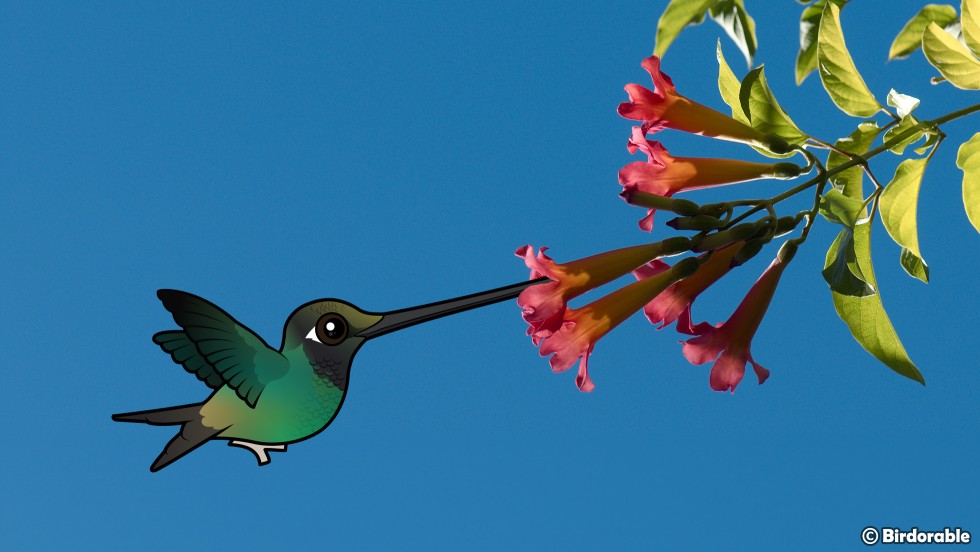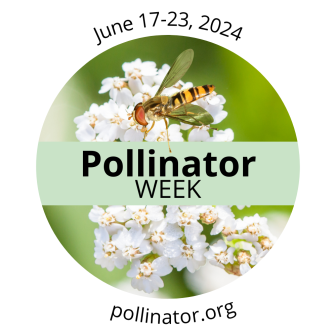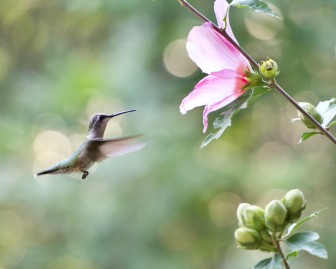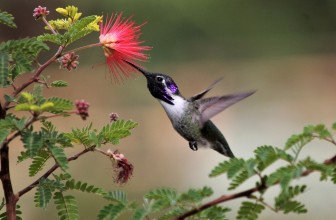Hummingbird Week 2024
Pollinator Week Is Here! We're Celebrating Avian Pollinators: Hummingbirds!

Sword-billed Hummingbird pollinating a trumpet flower in South America.

It's 🌺 Pollinator Week 🌺 June 17-23, and we're here to celebrate an important family of birds that acts as pollinators across the New World: Hummingbirds! It's Hummingbird Week here at Birdorable! We'll be celebrating with posts featuring hummingbird facts, busting hummingbird myths, and more. Of course, we'll be adding some new hummingbirds to our Birdorable family as well! Join us this week as we celebrate hummingbirds, and pollinators!
Why Pollinators Are Important
Pollinators, including bees, butterflies, bats, and birds, play a crucial role in both ecosystems and agriculture. Pollinators facilitate the reproduction of flowering plants by transferring pollen from one flower to another, enabling the plants to produce fruits, seeds, and more plants. This process is essential for the growth of many crops and wild plants, contributing to biodiversity and food security. Pollinators are responsible for pollinating 75-95% of the world's flowering plants and up to 75% of global food crops, like fruits, vegetables, and nuts. Their activity supports healthy ecosystems, which in turn provide clean air, water, and habitats for other wildlife.
Hummingbirds As Pollinators
Hummingbirds are among nature's most fascinating pollinators, playing a crucial role in the ecosystem by helping to fertilize flowers and promote plant diversity. Here are some interesting facts and insights into their role as pollinators.
Specialized Feeding Adaptations
Hummingbirds have long, slender bills and extendable tongues that allow them to reach deep into flowers to access nectar. This specialized feeding adaptation makes them effective pollinators for a variety of tubular flowers that other pollinators cannot reach.

Ruby-throated Hummingbird hovering by Ross Fanning (CC BY 2.0)
Hovering Ability
Unlike many other birds, hummingbirds can hover in mid-air thanks to their rapid wing beats, which can reach up to 80 beats per second. This ability allows them to feed from flowers without landing, minimizing damage to the blooms and increasing pollination efficiency.
Mutualistic Relationships
Many plants have evolved to attract hummingbirds specifically. These plants often have bright red or orange tubular flowers, which are particularly appealing to hummingbirds. In return for providing nectar, the plants benefit from the pollination services that hummingbirds provide as they transfer pollen from flower to flower. Sword-billed Hummingbirds, the only species of bird that has a bill longer than its body, typically feed on flowers with exceedingly long tubes that can only be reached by them.
Long-distance Pollinators
Some hummingbirds are known for their long migrations, with some species traveling thousands of miles between breeding and wintering grounds. During these migrations, they pollinate plants across vast distances, contributing to genetic diversity and plant reproduction over a wide area.
Ecological Impact
Hummingbirds play a significant role in maintaining the health and diversity of ecosystems. By pollinating a wide range of plant species, they help ensure the survival of many plants, which in turn provide food and habitat for other wildlife.
Color Vision
Hummingbirds have excellent color vision and are particularly attracted to bright colors. This trait helps them locate flowers quickly and efficiently. Plants that rely on hummingbirds for pollination often have brightly colored flowers to attract these avian visitors.

Costa's Hummingbird feeding on flower by Renee Grayson (CC BY 2.0)
Pollination Efficiency
Hummingbirds are highly efficient pollinators due to their ability to visit numerous flowers in a single foraging trip. As they move from flower to flower, pollen sticks to their bills and feathers, facilitating cross-pollination and increasing the genetic diversity of the plants they visit.
Adaptation to High Metabolism
Hummingbirds have an extremely high metabolism, requiring them to consume up to half their body weight in nectar each day. This constant need for food drives them to visit hundreds of flowers daily, making them prolific pollinators.
Keystone Species
In some ecosystems, hummingbirds act as keystone species. Their pollination activities are crucial for the survival of certain plants, which in turn support other species. The presence of hummingbirds can thus have a profound impact on the entire ecosystem.
Hummingbird Week!
Hummingbirds are essential pollinators with specialized adaptations that make them uniquely suited to their role. Their interactions with plants drive ecological processes and contribute to the health and diversity of ecosystems. By understanding and supporting hummingbird conservation, we can help maintain the balance and beauty of the natural world. You can see why hummingbirds and their role as pollinators is important. Join us this week as we celebrate hummingbirds here on the blog!













Comments
Leave a comment
Thank you!